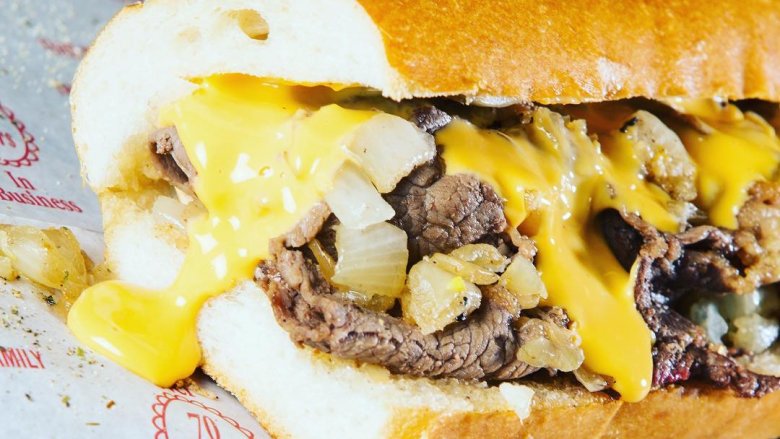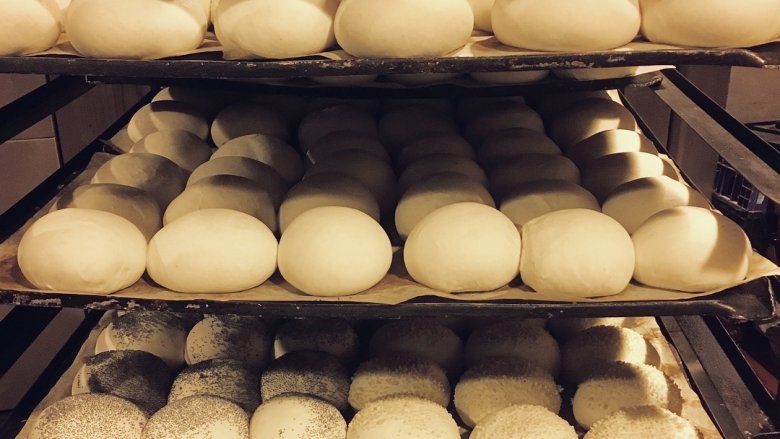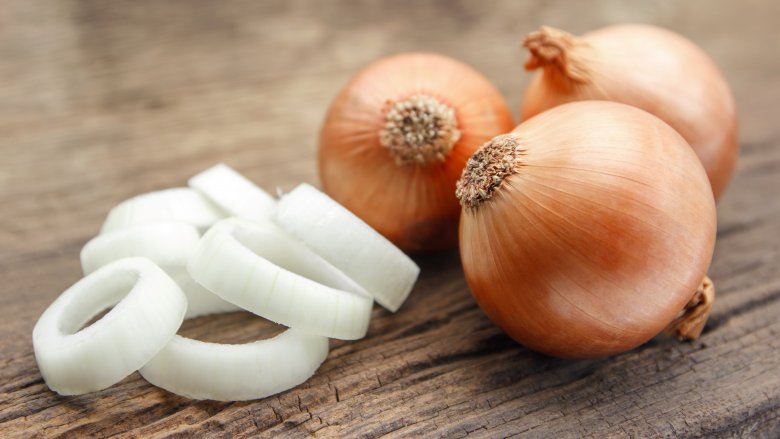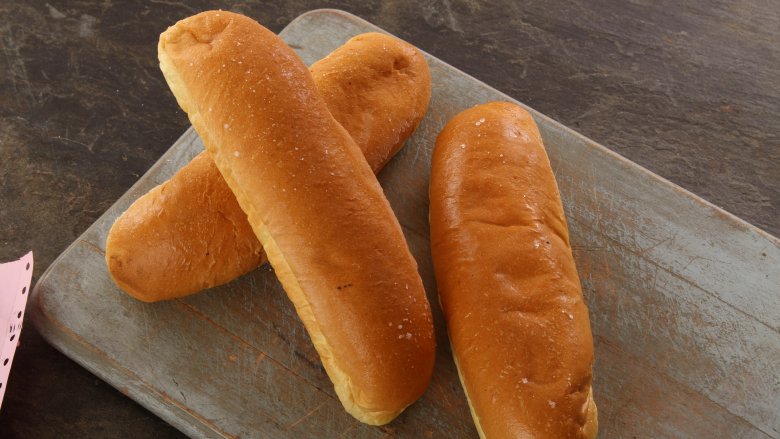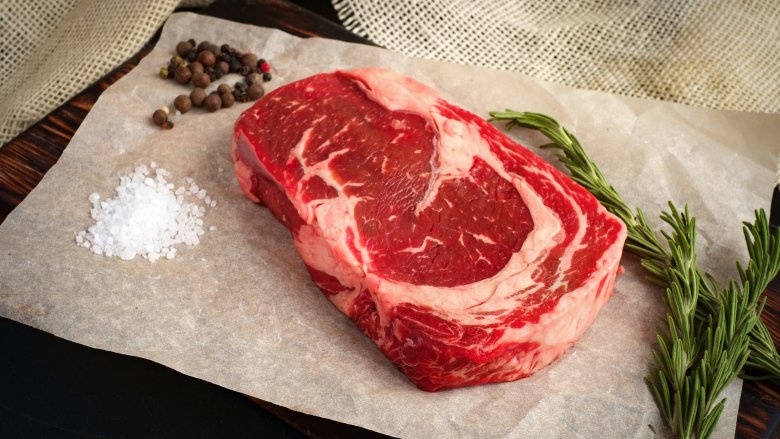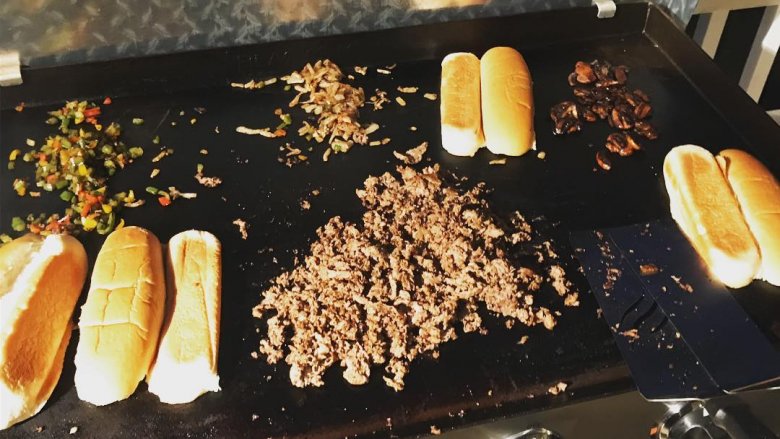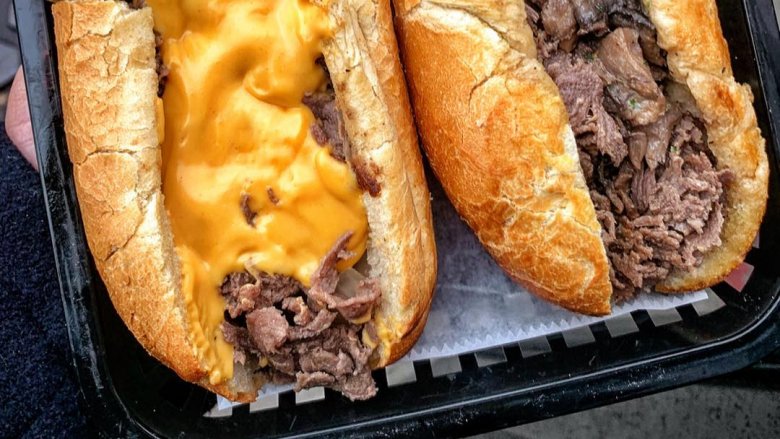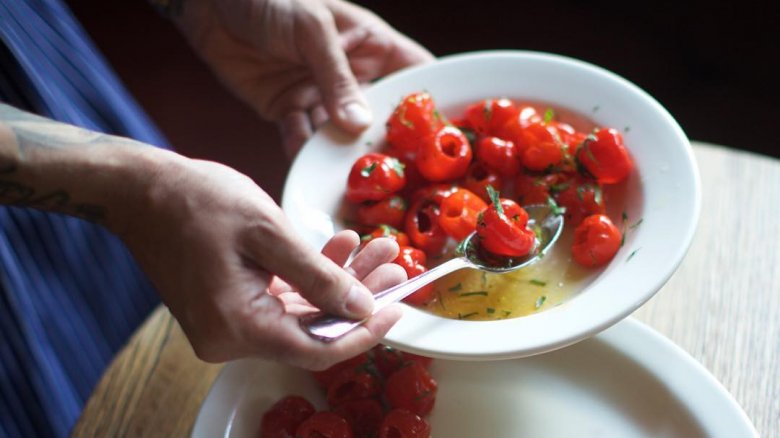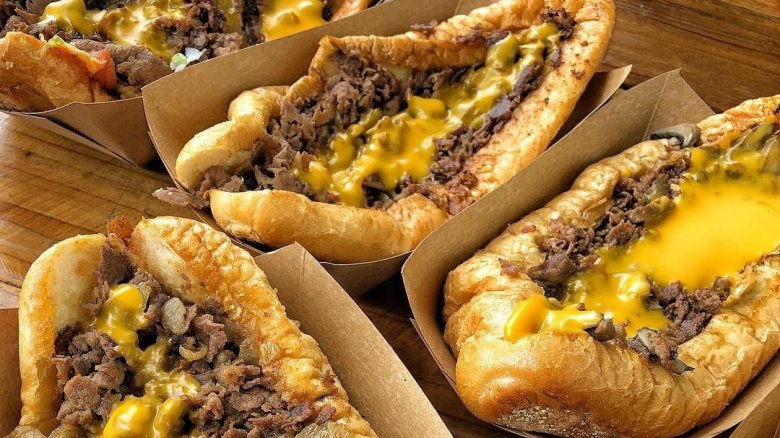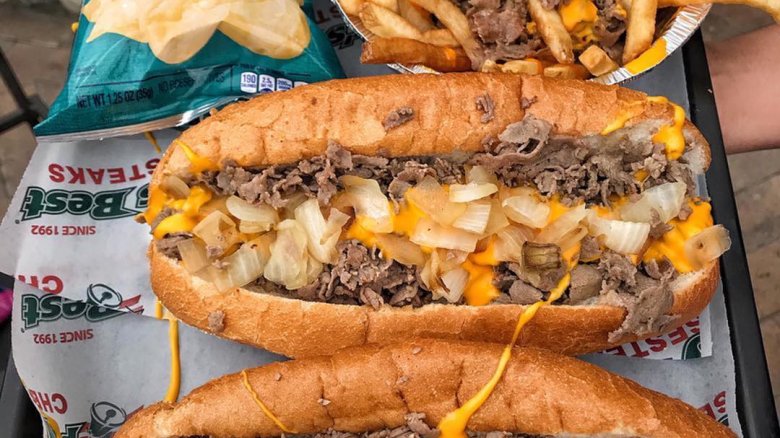The Real Reason Philly Makes The Best Cheesesteaks
We may receive a commission on purchases made from links.
The craving comes out of nowhere. And if you're anything like us, it probably comes once a month, and never really gets satisfied. That freshly-baked, ever so slightly crusty on the outside, soft in the middle loaf of bread, stacked with paper-thin ribbons of sliced ribeye steak and griddled onions, a sea of artificial cheese (or real cheese, if you want... this is your fantasy) binding the ingredients into a unified whole, coating the meat and vegetables in a layer of richness, running in rivulets out of the bottom of the sandwich with each bite.
Unless you're fortunate enough to live in the City of Brotherly Love, this intense cheesesteak craving can be a tough itch to scratch. Sure, you can get a "steak and cheese" from the sandwich place down the street, and yes, they will be arranging meat and cheese in a similar way on a similar roll. But "similar" isn't going to cut it, when we're talking about a real Philly Cheesesteak, is it? Here are the reasons why Philly makes the best cheesesteaks in the world, and why every other steak sandwich pales in pathetic comparison.
Freshness
There are a lot of sandwich shops out there that tout the freshness of their ingredients. But few can match a local favorite Philly cheesesteak shop in terms of sheer volume. This means that even very popular sandwich shops in other parts of the country are only getting fresh product delivered once or twice a week, which is plenty for pushing out a few hundred sandwiches per day.
Compare that to the brisk business on a busy Saturday at Philly's own Pat's King of Steaks, inventor of the Philly cheesesteak, where a single location can churn out upwards of 6,000 cheesesteaks per day. That kind of insane volume means that fresh product isn't just a marketing buzzword; it's a logistical necessity. Each day, the shop likely receives multiple delivers of brand-spanking-fresh bread, meat, and vegetables, ensuring the freshest possible sandwich. Even when copycats get the formula for a cheesesteak right, few can compete with that level of freshness.
Onion choice is key
Onions and steak go together like, well, onions and steak. But you can't just run around slapping any old onion on a cheesesteak; the type of onion used, the way they're sliced (against the grain for stronger onion flavor, or lengthwise for milder), and the time and technique of cooking all make a difference. Cook onions too quickly, and they run the risk of getting burnt and bitter; too slow, and they caramelize into a thick jam and can become much too sweet.
Though there is some variation in how Philly cheesesteak shops approach the all-important onion question, most have settled on the following formula: Spanish onions, diced or chopped, and pre-cooked or very lightly caramelized. They're then either flashed on the grill with the meat at the last minute, or added to the sandwich separately. Some maverick shops may be treating their onions slightly differently, either by slicing different varieties of onions into slivers, or cooking them mixed in with the meat, When you're missing the unique flavor of a true Philly cheesesteak, you're probably eating a sandwich with onions not cooked the traditional way. It seems like a small thing, but it makes a big difference — and they know that in Philly.
It's the bread, silly
Philly cheesesteak bread brands are the subject of fierce loyalty that could probably fill an article all by themselves. The roll used on a true Philly cheesesteak isn't complicated, but there are subtleties at play that make it easy to spot an imitator: light and crisp, but not overly crunchy on the outside; and soft, tender but not overly chewy on the inside.
During the endless ongoing cheesesteak debate that we assume is the subject of nearly every conversation happening in Philadelphia at any given moment, many customers choose a favorite cheesesteak shop based on the brand of bread used. Most cheesesteak rolls come from Philly-centric bakeries, such as D'Ambrosio, Amoroso's, or Sarcone's. And while many of these legendary cheesesteak bakeries ship nationwide, experts agree that the frozen product just isn't the same; it can get crumbly and fall apart after defrosting, making the fresh-baked rolls available in Philadelphia tough to replicate elsewhere.
Cross-cut ribeye
Aside from being buried alive, being suddenly struck blind, or losing a limb in a freak gardening accident, we can all agree that one of the worst things that can happen in life is that moment when you close your eyes to bite into a cheesesteak, only to pull out a big, tough slab of meat, its tail-end slapping onto your chin and scalding your face with a million degrees of molten, liquefied cheese.
It's the mark of a carelessly-made cheesesteak, and quite simply, it never happens in Philadelphia. Philly cheesesteak maestros know what an important role meat prep plays in the finished product, chilling huge slabs of flavorful and richly-marbled ribeye before slicing the meat paper-thin against the grain, so that your teeth shear neatly through each bite. Lesser cheesesteaks in other parts of the country are often made with cheap, flavorless shaved frozen meat, or big chunks of sirloin, and it's just not the same.
That ribeye bastes in its own fat as it cooks
Most self-respecting cheesesteak shops in Philadelphia turn to the ribeye for their meat component, and for good reason: It's reasonably inexpensive compared to other cuts, packed full of beefy flavor, and has ribbons of life-giving fat laced throughout, which renders instantly on a hot grill, allowing the meat to continually baste in its own flavorful fat as it cooks into tender, charred ribbons.
Sure, you can use other cuts of meat: Bargain-basement shaved steak products that are ground up like Pringles and mashed together in some textural approximation of meat, leaner cuts, or even chunky sirloin tips, but each of these require the addition of some other kind of fat, like oil or butter, to keep the meat from sticking to the grill. In most Philly cheesesteak shops, the premium ribeye keeps itself well lubricated during the cooking process without the addition of extra ingredients, leading to unadulterated flavor bliss.
Cheese choice is key
Cheese choice is an important part of building a perfect Philly cheesesteak, and in a lot of places outside Philadelphia, you'll find a lot of fancy-pants sandwich shops turning their noses up at canned Cheez Whiz, a staple ingredient on the original. "It's not even real cheese," your local sandwich geek may proclaim, "and it doesn't have nearly the flavor or subtlety of a mature, washed-rind cave-aged Coulommiers." That may be, but Cheez Whiz (or processed pasteurized American, if you must) combines both intense meltability with a tendency to fuse the other ingredients in the sandwich into a singular mass of fatty perfection, with a flavor that's neither too sharp nor too mild.
As for those Cheez Whiz naysayers? The next time you're at a fancy cheese-and-canape party, and no one wants to sample your platter of Spicy Cheez Potachos, drop this mind grenade on your unsuspecting companions: Restaurant-grade Cheez Whiz actually contains a much higher percentage of cheese than its retail counterpart. Eat THAT, fromagers.
That pickled pepper, served on the side
It's an unorthodox cheesesteak ritual, and one we haven't seen much outside of Philly... that big drum of pickled hot cherry peppers that usually flanks the end of the condiment bar. True Philadelphia cheesesteak fanatics top their prized sandwiches in a lot of different ways. Opinions on toppings are divided; some people prefer to eat their cheesesteak naked, the way God intended, while others may opt for a dab of mayonnaise or a few shakes of hot sauce. But for pure, palate-confusing perfection, you have to stand in awe of the pickled pepper ritual: A few bites of cheesesteak, followed by a bite of spicy pickled pepper, followed by a few more bites of cheesesteak, until both the sandwich and the pepper are gone, and you have heartburn.
The heat and acid provides an excellent contrast to the rich fattiness of the meat, and it's a topping trend we'd love to see catch on in other parts of the country. For now, you're probably not going to see much of it outside of Philly.
Keep an eye out for the drip
That tiny drip of liquid spilling out of the back of your cheesesteak, a finely-blended slurry of grease, fat, liquefied cheese, and onion sweat? THAT'S the mark of a perfect cheesesteak, and one you're only going to find in Philadelphia.
According to The Daily Meal, "When you bite into a cheesesteak, ideally grease and cheese should drip from the other end of the roll onto the paper. If the drips become a stream, that's bad. 'No drips' can be really bad, depending on the cut of steak. Some slab-cut steaks don't have much of a drip at all, which isn't as much of an issue as long as the meat is cooked to a nice medium tenderness. But there's that magical drip mean with most steaks that denotes a true mastery on the part of the grill man."
If your cheesesteak is as dry as a desert, or at the other end of the moisture spectrum, is spouting great fountain sprays of grease out of back of the sandwich as you eat, you're probably not eating a cheesesteak in Philadelphia.
Balanced cheese-to-meat ratios
A true Philly cheesesteak is a perfectly balanced sandwich, and getting this ratio just right seems to be the downfall of a lot of the sub-par cheesesteaks you'll find elsewhere around the country. Many places put too much emphasis on one element over another, either stuffing your sandwich with more meat than anyone should ever eat in one sitting, or ladling on a too-heavy pour of some overwrought cheese fondue. Sure, we love these elements, but only when they're served in careful balance with the other ingredients. This careful balancing act of ingredients gets even trickier when you start adding mushrooms, green peppers, jalapenos, horseshoes, silk pillowcases, or other common cheese steak upgrades, and if you're not careful, you'll end up with a wildly overstuffed sandwich that bears little resemblance to the balanced perfection of the original. Too many onions, too much meat, too much cheese...they're all indicators that you're eating a cheesesteak somewhere outside of the cheesesteak's birthplace.
